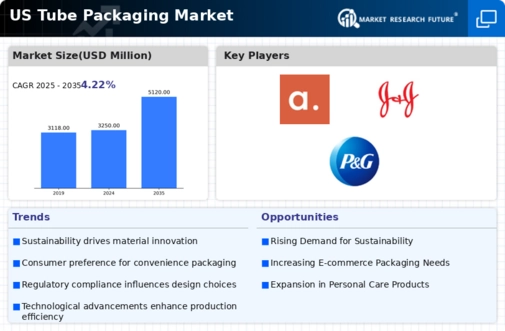Technological Innovations in Packaging
Technological advancements are playing a crucial role in shaping the tube packaging market. Innovations such as smart packaging, which incorporates QR codes and NFC technology, are enhancing consumer engagement and providing valuable product information. Furthermore, advancements in printing technology allow for high-quality graphics and customization options, making tube packaging more attractive to consumers. The integration of these technologies is expected to boost the market, as brands seek to differentiate themselves in a competitive landscape. As a result, the tube packaging market is expected to witness a surge in demand for technologically advanced solutions.
Rising Demand for Eco-Friendly Solutions
the tube packaging market is undergoing a notable shift towards eco-friendly solutions, driven by increasing consumer awareness regarding environmental sustainability. As more consumers prioritize sustainable products, manufacturers are compelled to adopt greener practices. This trend is reflected in the growing use of biodegradable and recyclable materials in tube packaging. According to recent data, the market for sustainable packaging is projected to grow at a CAGR of approximately 7.5% through 2026. This shift not only aligns with consumer preferences but also helps companies reduce their carbon footprint, thereby enhancing their brand image in the tube packaging market.
E-commerce Growth and Changing Consumer Behavior
The rise of e-commerce is significantly impacting the tube packaging market, as more consumers turn to online shopping for their product needs. This shift in consumer behavior necessitates packaging that is not only visually appealing but also durable enough to withstand shipping and handling. Tubes, with their lightweight and resilient design, are increasingly favored for e-commerce applications. In 2025, e-commerce sales in the US are projected to exceed $1 trillion, further driving demand for effective packaging solutions. As a result, the tube packaging market is likely to benefit from this trend, as brands adapt to the evolving retail landscape.
Growth in the Cosmetics and Personal Care Sector
the tube packaging market is notably influenced by the expansion of the cosmetics and personal care sector. With the increasing demand for beauty products, manufacturers are seeking innovative packaging solutions that enhance product appeal and functionality. In 2025, the cosmetics industry in the US is expected to reach a valuation of over $90 billion, with a substantial portion of this growth attributed to tube packaging. This trend indicates that brands are increasingly opting for tubes due to their convenience, portability, and ability to preserve product integrity, thereby driving growth in the tube packaging market.
Increased Focus on Product Safety and Preservation
the tube packaging market is driven by an increased focus on product safety and preservation. As consumers become more health-conscious, the demand for packaging that ensures product integrity and extends shelf life is rising. Tubes are particularly effective in protecting sensitive products, such as pharmaceuticals and cosmetics, from contamination and degradation. This trend is supported by data indicating that the pharmaceutical packaging market is projected to grow at a CAGR of 6% through 2027. Consequently, the emphasis on safety and preservation is likely to propel growth in the tube packaging market.














Leave a Comment